Exploring Intestinal Epithelial Cell Structure and Function
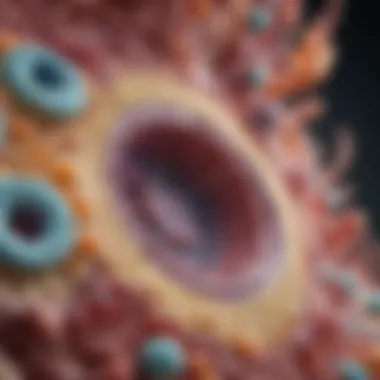
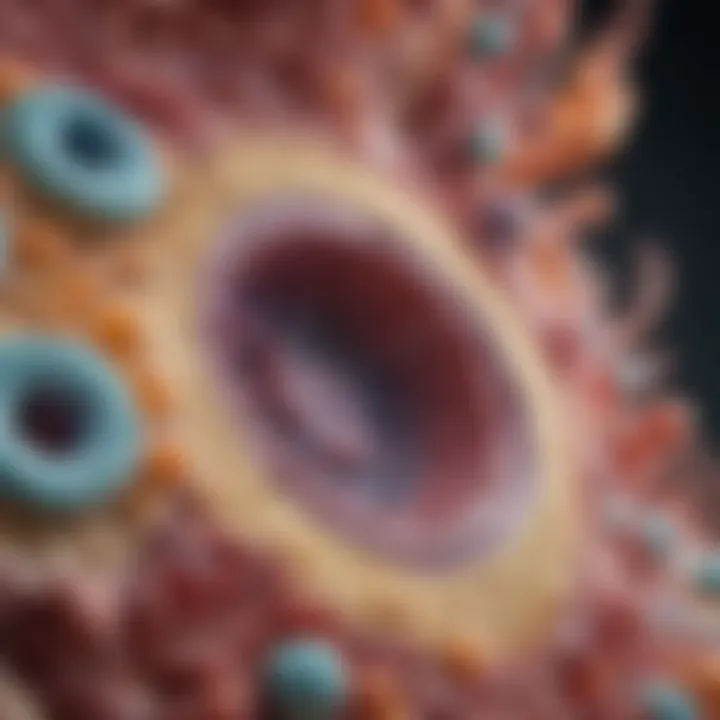
Intro
The intestinal epithelial cells serve as the frontline protectors and facilitators of the digestive system, playing a crucial role in nutrient absorption and barrier function. Their structure is not just a matter of aesthetics; it is intrinsically linked to their diverse functions. Understanding the anatomy and cellular interactions of these cells can reveal much about gastrointestinal health, the onset of diseases, and the body's response to various environmental factors.
The intestinal epithelium is a dynamic entity composed of several specialized cell types, each tailored to meet specific roles within the gut. Notably, enterocytes, goblet cells, and Paneth cells, among others, exhibit unique structural features and functional properties. The organization of these cells reflects both evolutionary adaptations and the immediate physiological demands placed on them.
In a world increasingly focused on health, diet, and the underlying biology of the gut, the exploration of intestinal epithelial cell structure is more relevant than ever. With the rise of gastrointestinal disorders and an increasing interest in the gut microbiome, this area of study offers significant insights into maintaining homeostasis in the gastrointestinal tract.
This article aims to provide a comprehensive guide, peeling back layers to reveal how the architecture of intestinal epithelial cells lays the groundwork for their vital interactions and roles within the body.
Research Highlights
Overview of Key Findings
- The primary cell types found within the intestinal epithelium include enterocytes, which specialize in nutrient absorption, goblet cells, which secrete mucin for lubrication and protection, and Paneth cells, which provide an immune response against pathogens.
- The structural arrangement of these cells creates a barrier that is selectively permeable, allowing essential nutrients to be absorbed while preventing harmful substances from entering the bloodstream.
- Tight junctions between epithelial cells play a pivotal role in maintaining the integrity of the epithelial barrier, ensuring that the cells function effectively in nutrient uptake while also protecting against pathogenic infiltration.
- Morphological variations along the intestine—from the duodenum to the ileum—highlight adaptations that cater to distinct digestive contexts.
Significance of the Research
Understanding intestinal epithelial cell structure is essential for several reasons:
- Health Implications: A clear comprehension of cellular behavior and adaptations can lead to a better understanding of conditions like celiac disease, inflammatory bowel diseases, and colorectal cancer.
- Dietary Influences: Insights into how different nutrients influence cellular functions may inform dietary recommendations tailored to improve gut health.
- Future Therapies: Innovations in targeting epithelial cell functions present new avenues for therapeutic interventions against various gut-related illnesses.
"A deeper understanding of the intestinal epithelial architecture holds the key to unlocking potential strategies for a plethora of health concerns tied to our gut."
Original Research Articles
Summary of the Article
Recent studies illuminate the intricate connectivity between epithelial cell structure and their diverse physiological roles. Methodologies such as immunofluorescence and 3D imaging have unveiled previously unobserved cellular dynamics. For instance, the responsiveness of Paneth cells to microbial stimuli reflects their importance in maintaining gut flora equilibrium.
Author Contributions
Contributors from various backgrounds have brought to light essential aspects of intestinal epithelial cell biology. Research from molecular biologists, physiologists, and clinical experts coalesces to provide a rounded perspective.Each has played a critical role in piecing together the puzzle of how these cells contribute to the larger narrative of gastrointestinal health.
This comprehensive study aims to bridge gaps in existing knowledge, equipping students, researchers, and educators with crucial insights into a fundamental aspect of human biology.
Overview of Intestinal Epithelium
The intestinal epithelium forms a crucial barrier between the body and the external environment, situated within the gut. Understanding its structure is fundamental for grasping how the human digestive system operates. This overview serves as a foundation upon which the intricate functionalities of these epithelial cells can be built. Given the constant interplay between nutrients, microbes, and immune responses happening in the gut, intestinal epithelial cells must maintain their integrity and function.
Prologue to Intestinal Epithelial Cells
Intestinal epithelial cells are like the sentinels of our digestive tract, performing several roles. They exhibit a remarkable diversity, adapting to various functions that ensure we extract nutrients effectively while also serving as a defensive barrier. The major players in this landscape include enterocytes, goblet cells, Paneth cells, and enteroendocrine cells. Each one has its own responsibilities, and together they orchestrate a finely tuned process that supports not just digestion but overall health. Think of them as members of a well-rehearsed team, each contributing to the smooth running of the gut, ensuring that nutrition comes through without skipping a beat.
Importance of Intestinal Epithelial Structure
The structure of the intestinal epithelium is of utmost significance. This multilayered architecture facilitates maximal absorption of nutrients while also providing a barrier against pathogens and toxins. The tight junctions between cells regulate which substances can cross into the bloodstream, maintaining a delicate balance that is vital for homeostasis. If these junctions were to falter, the consequences could be dire, leading to conditions like leaky gut syndrome.
- Cell Types and Their Roles:
- Enterocytes: Actively absorb nutrients from digested food.
- Goblet Cells: Produce mucus to lubricate the intestinal lining.
- Paneth Cells: Help regulate gut flora and protect against infections.
- Enteroendocrine Cells: Secrete hormones that influence digestion and metabolism.
This layered complexity is not merely for show; it allows the intestinal epithelium to respond to various stimuli, making adjustments as needed. For instance, during inflammation, specific pathways can be activated to enhance immune responses, showcasing how structure and function are intricately linked.
"The intestinal epithelium is not just a passive barrier; it is a dynamic interface that regulates nutrient absorption and immune responses."
Students, researchers, and healthcare professionals find the study of this epithelium vital, as it serves as the basis for understanding a multitude of gastrointestinal conditions. From benign ailments to life-threatening diseases, many originate in the functionality of these cells. The more comprehensively we explore this subject, the better equipped we become to tackle issues related to gastrointestinal health.
Cellular Composition of Intestinal Epithelium
Understanding the cellular composition of the intestinal epithelium is crucial, as it lays the groundwork for comprehending how these cells function as a cohesive unit. The complexity of the intestinal epithelium is remarkable and inherently tied to its roles in digestion, barrier protection, and nutrient absorption. Each type of cell present contributes uniquely, ensuring the integrity, resilience, and adaptability of the epithelial layer within the gastrointestinal tract.
The health of the intestine relies heavily on the coordinated interaction of various cell types. When we focus on these cellular components, we gain insights into their distinct functions and how they interact to maintain gut homeostasis. For instance, issues in the composition can lead to numerous gastrointestinal disorders, including malabsorption syndromes and inflammatory bowel diseases. Thus, exploring these cells is paramount not just for academic understanding but also for evaluating therapeutic strategies targeting intestinal health.
Enterocytes: The Primary Absorptive Cells
Enterocytes are the dominant cell type found in the intestinal epithelium, primarily responsible for nutrient absorption. They are elegantly structured, presenting a brush border, which is laden with microvilli, effectively increasing the surface area for absorption. This design allows for optimal exploitation of nutrients from digested food, playing a vital role in providing energy and substrates for bodily functions.
- Structure: Each enterocyte consists of specialized membranes; the apical membrane faces the intestinal lumen while the basolateral membrane interfaces with underlying tissues.
- Function: They transport nutrients such as amino acids, glucose, and fatty acids through mechanisms like active transport and passive diffusion.
Additionally, enterocytes partake in the digestion process by expressing various enzymes like disaccharidases. This functionality transforms complex carbohydrates into simpler sugars. Overall, enterocytes are indispensable for sustaining nutritional health.
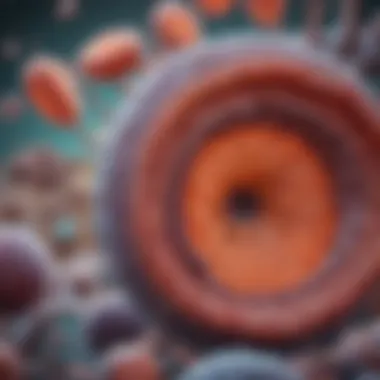
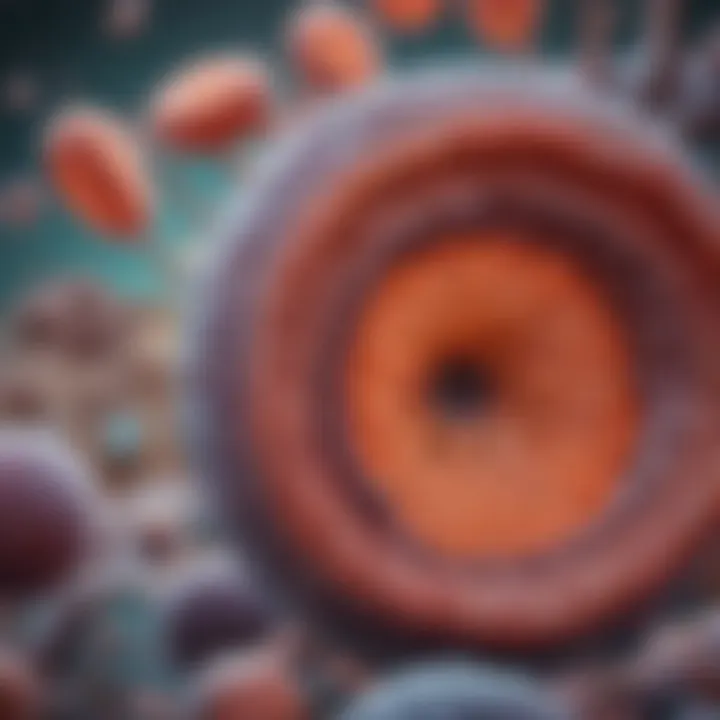
Goblet Cells: Mucus Producers
Goblet cells contribute to intestinal integrity by secreting mucus, thus forming a protective layer over the epithelial surface. These specialized cells have a unique morphology resembling a goblet, which is where their name comes from.
- Role of Mucus: Mucus serves as a physical barrier, shielding epithelial cells from mechanical damage and microbial invasion.
- Fluidity and Moisture: The mucus produced is not just a protective layer; it also ensures that food particles can transit smoothly through the intestines during digestion.
The balance in mucus production is critical; overproduction might lead to obstructive conditions while underproduction can expose the epithelium to potential harm, emphasizing the goblet cells’ importance in maintaining homeostasis.
Paneth Cells: Defenders of the Gut
Paneth cells are relatively less abundant but play a significant role in the gut's immune defenses. Positioned at the base of the intestinal crypts, they act as guardians by secreting antimicrobial peptides and enzymes, such as lysozyme, that target harmful pathogens.
- Defense Mechanism: Through their secretions, Paneth cells contribute significantly to the gut microbiome's balance by maintaining an environment that favors beneficial bacteria while restricting pathogen growth.
- Signaling Role: They also produce signaling molecules that can influence cell differentiation and regeneration, linking them to gut health and disease.
Enteroendocrine Cells: Hormonal Regulation
Enteroendocrine cells stand out due to their role in hormonal regulation. While they are sparse compared to enterocytes and goblet cells, their influence is profound. They secrete hormones like gastrin, cholecystokinin, and serotonin, which are crucial for regulating gastrointestinal physiology.
- Functions:
- Gastrin stimulates gastric acid secretion, aiding in digestion.
- Cholecystokinin signals the gallbladder to release bile.
- Serotonin is involved in peristalsis and gut motility.
Their ability to sense nutrients and send feedback makes enteroendocrine cells vital for communicating with other systems in the body, asserting their role in not just digestion but overall homeostasis.
Stem Cells: The Source of Cellular Renewal
At the base of the intestinal crypts lie the stem cells, the unsung heroes of the intestinal epithelium. These cells possess the unique ability to differentiate into various cell types, thus playing an essential role in the regeneration process.
- Renewal Cycle: The intestinal epithelium undergoes a rapid turnover, with cells replaced every few days. Stem cells are responsible for this continual renewal, ensuring that any damaged or dysfunctional cells are replaced in a timely manner.
- Significance in Health and Disease: Disturbances in stem cell function can lead to compromised intestinal integrity and have been implicated in conditions such as cancer.
In summary, the interplay among enterocytes, goblet cells, Paneth cells, enteroendocrine cells, and stem cells creates a versatile and resilient intestinal epithelium. Each cell type contributes significantly to various functions that maintain gut health and overall well-being.
Morphological Features of Intestinal Epithelial Cells
Understanding the morphological features of intestinal epithelial cells is essential, as these structures play a vital role in digestive processes and overall gut health. The architecture of these cells is not just for show; it serves multiple purposes, including enhancing nutrient absorption, protecting against pathogens, and maintaining a balanced gut environment. Let's delve into some core components that make up these fascinating structures.
Cell Surface Modifications
Microvilli: The Brush Border
The microvilli form what’s often referred to as the brush border, a vast expanse of tiny finger-like projections that decorate the apical surface of enterocytes. Their unique and critical aspect lies in their ability to drastically increase the surface area available for absorption. Think about it: the more surface area, the more nutrients can be absorbed effectively.
A key characteristic of microvilli is their densely packed arrangement, forming a carpet-like layer that maximizes contact with digested food substances. This makes them a beneficial choice for highlighting the efficiency of nutrient absorption in this article.
On the flip side, there's a challenge: maintaining this structure requires significant energy and resources. Their delicate nature means they can be easily damaged by harsh conditions or toxins, which can hinder absorption and lead to gastrointestinal issues.
Apical Membrane Characteristics
The apical membrane is another vital feature of intestinal epithelial cells. Its primary role involves controlling the movement of substances into cells. It's like a large, intricate doorman, determining what comes in and what stays out. A key aspects of this membrane is the presence of various transporters and channels, which facilitate the selective uptake of nutrients, water, and electrolytes. This is crucial for maintaining the balance and health of the gut.
The unique feature of the apical membrane is its ability to adapt to different dietary conditions. For example, when one consumes a high carbohydrate diet, the expression of glucose transporters can increase. This flexibility becomes a double-edged sword, though; sudden changes in diet can sometimes overwhelm the membrane’s capacity to adjust, leading to potential absorption issues.
Basolateral Membrane Adaptations
The basolateral membrane adapts in much the same way as the apical side, playing a pivotal role in the absorption of nutrients. It focuses on transporting the absorbed nutrients into the bloodstream, ensuring they reach the rest of the body. This side has different sets of transporters, and they are specifically engaged in sending amino acids and sugars away from the gut epithelium. It effectively acts as the exit point for critical nutrients that have just been absorbed. The strategic organization of these transporters helps in maximizing nutrient uptake efficiency.
Cell Junctions and Barrier Function
Tight Junctions: Ensuring Selectivity
Tight junctions are like the seals around the windows of a house – they ensure that only specific things can pass through while preventing the entry of unwanted guests. These structures between cells create a barrier that regulates the passage of ions and small molecules, contributing to the selectivity of the intestinal barrier.
Their key characteristic is their complex network that provides strength while remaining pliable enough to adjust to changing intestinal conditions. This feature makes tight junctions a popular point of discussion in our article, as their integrity is critical for maintaining health.
However, if these junctions become compromised due to inflammation or infection, it can lead to broader issues such as increased intestinal permeability, often described colloquially as a “leaky gut.” This condition has been linked to many health problems, shaking the foundation of gut health.
Adherens Junctions: Cell Adhesion
Adherens junctions provide additional structural support among intestinal epithelial cells, acting like a belt that keeps things together. They play a crucial role in maintaining cell shape and structure, and they help cells connect with one another through cadherins. This cohesiveness between cells ensures that the epithelium acts as a united front against external threats.
This junction type is beneficial because it promotes the resilience of the epithelial layer; if one cell is damaged, the others can help keep the barrier intact. Yet, they must strike a balance as excessive adhesion can lead to reduced flexibility, which may restrict necessary cellular movements during instances like injury repair or inflammation.
In summary, the morphological features of intestinal epithelial cells reflect a well-orchestrated balance between structure and function. They are equipped to handle the complexities of nutrient absorption while defending against potential dangers that lurk in the gut environment.
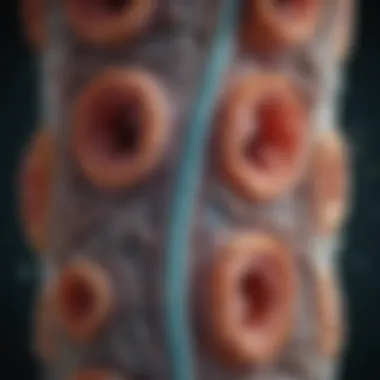
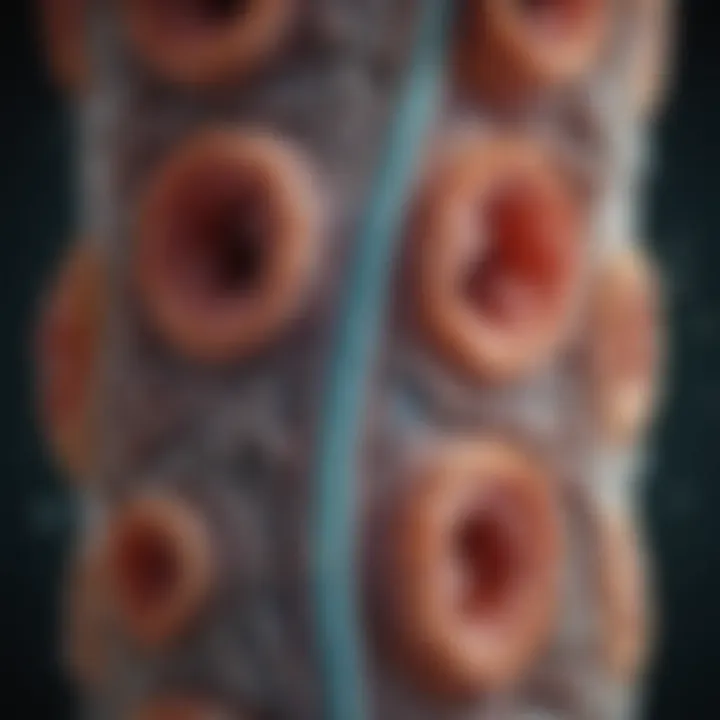
Functions of Intestinal Epithelial Cells
The role of intestinal epithelial cells extends far beyond mere structure; they are at the forefront of multiple critical functions within the digestive system. These cells are paramount in sustaining overall gut health and performing functions that facilitate nutrient absorption, protect from pathogens, and maintain a balanced internal environment. By focusing on the core functions of the intestinal epithelial cells, we can grasp their significance and the intricate balance they uphold in the gastrointestinal tract.
Nutrient Absorption Mechanisms
At the heart of digestive health lies the process of nutrient absorption. Intestinal epithelial cells, predominantly enterocytes, orchestrate the intricate dance of absorbing essential nutrients from the digested food. These cells possess specialized structures, such as microvilli, forming what is often called the brush border. This vast surface area significantly increases the capacity for absorption.
Nutrient absorption involves various mechanisms, including:
- Passive Diffusion: Small molecules such as water and some lipids pass through the cell membrane without energy expenditure.
- Facilitated Diffusion: Other nutrients utilize specific transport proteins embedded in the cell membrane, allowing substances like glucose or fructose to enter the cells passively.
- Active Transport: This process requires energy, as it moves nutrients against their concentration gradient. An example is sodium-glucose transport, where sodium ions help glucose molecules get absorbed even in low concentrations.
Understanding these mechanisms sheds light on how nutritional deficiencies may arise. For instance, if enterocyte function is compromised, it may lead to significant absorption issues, impacting overall health.
Barrier Protection and Immune Response
The intestinal epithelium serves as a formidable barrier, blocking harmful substances while allowing nutrients through. Epithelial cells form tight junctions, ensuring that unwanted pathogens and toxins cannot slip through the spaces between them. This barrier is not only a physical defense but also plays a crucial role in the immune response.
The epithelial cells interact with various immune cells. For example, Paneth cells release antimicrobial molecules that help maintain the balance of gut microbiota and fend off pathogenic bacteria. These interactions help establish a suitable environment that fosters a healthy gut microbiome, which is essential for overall health.
- Immediate Response: Upon detecting threats, the epithelial cells can signal immune cells to launch a response.
- Chronic Regulation: The continuous production of mucus by goblet cells helps trap pathogens and facilitate their expulsion from the gut while keeping the epithelial surface hydrated.
"The intestinal epithelium is a dynamic interface where the immune system and dietary intake intertwine, playing a constant role in health or disease."
Maintenance of Gut Homeostasis
Homeostasis within the gut is facilitated primarily by the intestinal epithelial cells. They regulate the balance between absorption and secretion, ensuring that the digestive environment remains optimal for digestion and absorption.
The epithelial layer communicates with the microbiota and the immune system, adapting in response to dietary changes, stressors, or disease states. Some essential aspects of this homeostatic maintenance include:
- Secretion of Enzymes and Mucus: Alongside nutrient absorption, epithelial cells secrete enzymes that further aid in digestion, and the mucus traps particulate matter and protects the cells.
- Regeneration: Intestinal epithelial cells are among the fastest-renewing cells in the body. Stem cells located in the crypts of the intestine continually replenish these cells, replacing those that are sloughed off from the villi.
- Nutrient Sensing: They possess the ability to sense nutrient levels and subsequently adjust their absorption capabilities and secretions, ensuring the gut adapts to changing dietary inputs.
This self-regulating system is essential to prevent conditions such as inflammatory bowel disease or irritable bowel syndrome, which can result from a breakdown in this homeostatic balance.
Through these various functions, intestinal epithelial cells illustrate their importance in maintaining health and preventing disease, indicating that their study is vital for understanding not just the gut but the entire body's physiology.
Interactions with Gut Microbiota
The interplay between intestinal epithelial cells and gut microbiota is fundamental to digestive health. This relationship not only facilitates digestion but also plays a pivotal role in immune system functioning and overall gut maintenance. Understanding how these two systems communicate offers insights into several aspects of health and disease, making it an essential topic to explore.
The Role of Gut Microbes in Epithelial Health
Gut microbes, often referred to as the gut microbiota, inhabit the intestines in vast quantities. These microorganisms, including bacteria, viruses, fungi, and archaea, contribute tremendously to the health of the intestinal epithelium. They help in digesting complex carbohydrates and synthesize vital nutrients like certain vitamins that would be otherwise inaccessible.
Moreover, gut microbes aid in maintaining the integrity of the epithelial barrier. They stimulate epithelial cell turnover and modulate immune responses. For instance, certain strains of Lactobacillus and Bifidobacterium can enhance mucin production, a glycoprotein that forms a protective layer over intestinal cells, thus decreasing permeability to pathogens and toxins.
"The gut microbiota acts as a silent partner in health, influencing everything from nutrient absorption to immune modulation."
Epithelial Response to Microbial Signals
The interaction between microbial communities and epithelial cells isn't just passive. It's a dynamic exchange where each party influences the other. Epithelial cells possess toll-like receptors (TLRs) that detect microbial patterns and trigger responses. Upon recognition of these microbial signals, epithelial cells can modulate their function and behavior accordingly.
For example, when pathogenic bacteria are detected, epithelial cells can increase the production of antimicrobial peptides, enhancing the body's defense mechanisms. They can also adjust tight junctions, which serve as physical barriers to maintain intestinal integrity. This responsiveness is crucial; it allows for a flexible barrier that can react promptly to threats while sustaining normal physiological functions.
Implications for Disease States
The relationship between gut microbiota and intestinal epithelial cells has significant implications for various disease states. An imbalance in the gut microbiome, often characterized by a decrease in diversity and a predominance of pathogenic species, can lead to intestinal disorders.
- Irritable Bowel Syndrome (IBS): Research suggests that altered microbiota composition can exacerbate symptoms of IBS. Reactive epithelial cells might not function optimally, leading to increased permeability, often referred to as “leaky gut.”
- Celiac Disease: In individuals with a genetic predisposition, the microbial environment can influence the severity of gluten sensitivity. Dysbiosis can trigger aberrant immune responses, resulting in damage to the epithelial lining and ongoing inflammation.
- Metabolic Diseases: An unhealthy microbiome is linked with obesity and diabetes. The way that epithelial cells absorb nutrients and fats can directly impact metabolic pathways, often resulting in adverse health outcomes.
Understanding these interactions is fundamental for developing potential therapeutic strategies. By modulating microbial populations or enhancing epithelial resilience, it may be possible to prevent or treat various gastrointestinal disorders.
Impacts of External Factors on Intestinal Epithelium
The intestinal epithelium serves as a vital barrier between the internal body and the external environment, making it susceptible to various external influences. Understanding how these factors affect epithelial cell structure and function is crucial in current biomedical research and clinical practice. Each element, whether it be diet, environmental toxins, or pharmaceutical substances, holds the potential to disrupt the delicate balance that maintains epithelial integrity and function. Analyzing these influences helps to pinpoint strategies for preserving gut health and mitigating disease.
Dietary Influences on Epithelial Function
The food we eat plays a significant role in shaping the health of intestinal epithelial cells. A well-balanced diet rich in fiber, vitamins, and essential nutrients can enhance epithelial repair and function. Fiber, for instance, is fermented by gut microbes, yielding short-chain fatty acids that nourish epithelial cells and strengthen the intestinal barrier.
Conversely, a diet high in processed foods, sugars, and unhealthy fats can lead to inflammation and dysbiosis, which in turn compromise epithelial cell integrity. Emerging research suggests that a diet lacking in essential nutrients can lead to atrophy of epithelial cells, making them more vulnerable to damage from pathogens.
Key dietary factors to consider include:
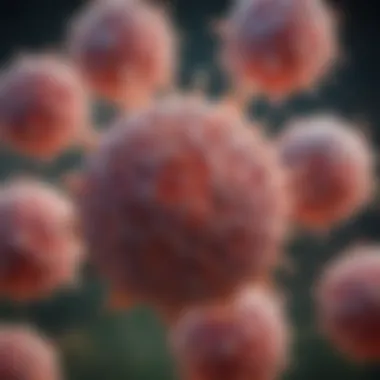
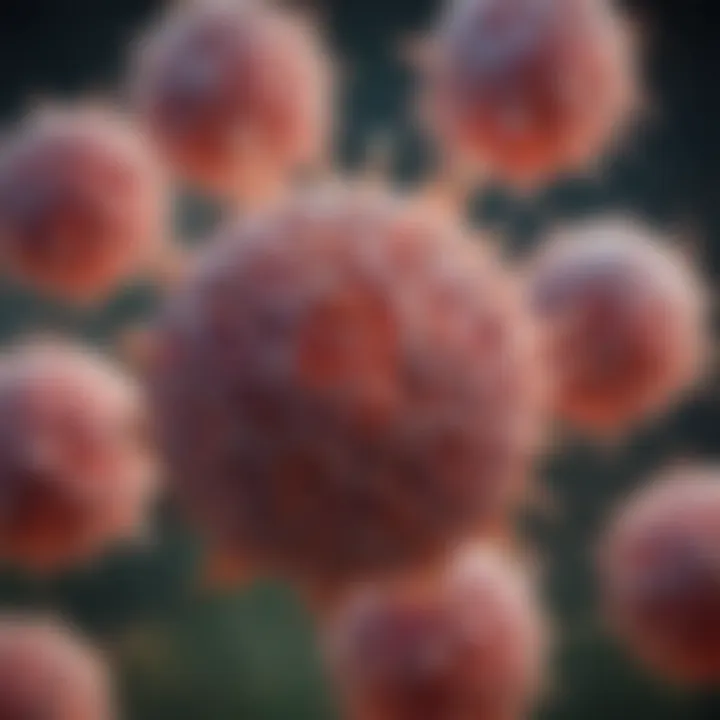
- Fiber rich foods: Whole grains, fruits, and vegetables.
- Healthy fats: Unsaturated fats found in fish and nuts.
- Elimination of excessive sugars: Reducing sugary snacks can lower inflammation.
Maintaining a well-rounded diet is more than just a lifestyle choice; it’s a fundamental aspect of sustaining a healthy intestinal epithelium.
Effects of Toxins and Pathogens
A broad spectrum of environmental toxins and pathogens can directly harm the epithelial cells in the intestines. Chemicals like pesticides, heavy metals, and certain additives in food can disrupt cell structure and function, leading to increased permeability, commonly termed ‘leaky gut.’ This condition allows undigested food particles and microbes to enter the bloodstream, triggering inflammatory responses that may result in chronic diseases.
On top of that, pathogens such as bacteria, viruses, and parasites pose a significant threat. Clostridium difficile, for example, is known to cause severe infection and disrupt the epithelial barrier, which can lead to life-threatening colitis. Even daily exposure to common pathogens can exert long-term detrimental effects on epithelial health.
"Pathogens not only invade but also alter epithelial cell signaling, which can change their normal functions significantly."
The Role of Pharmaceuticals
Pharmaceuticals are another external factor that can adversely affect intestinal epithelial cells. Medications like non-steroidal anti-inflammatory drugs (NSAIDs) are well-documented for their potential to damage the epithelial lining of the gut, sometimes leading to gastrointestinal complications. Prolonged use can result in an imbalance of microbial communities, fostering conditions that compromise epithelial integrity.
Interestingly, some drugs designed to treat gastrointestinal disorders may have conflicting effects. For instance, while certain probiotics are formulated to enhance gut health, others can induce a cascade of reactions that disturb the existing microbiota balance. Careful consideration of the impact of medications on the gut lining is essential for effective treatment strategies.
In summary, external factors such as diet, toxins, pathogens, and pharmaceuticals can profoundly impact the structure and function of the intestinal epithelium. Understanding these influences assists researchers and healthcare professionals in developing better approaches to safeguard intestinal health and promote healing.
Pathological Conditions Affecting Epithelial Cells
Pathological conditions significantly impact the integrity and function of intestinal epithelial cells. These cells are the frontline defenders of gut health, playing a pivotal role in barrier function, nutrient absorption, and immune response. Disruptions in their structure or function can lead to a cascade of health issues, ranging from digestive disorders to systemic diseases. Understanding these conditions not only helps in diagnosing various gastrointestinal ailments but also highlights potential therapeutic targets for intervention.
Irritable Bowel Syndrome and Epithelial Dysfunction
Irritable Bowel Syndrome (IBS) is among the most common gastrointestinal disorders, affecting a vast number of individuals worldwide. It is characterized by a spectrum of symptoms including abdominal pain, bloating, and altered bowel habits, but the underlying mechanisms remain elusive.
Research indicates that epithelial dysfunction is a key player in IBS. In patients suffering from this condition, the integrity of the epithelial barrier often appears compromised. The tight junctions that typically seal gaps between intestinal epithelial cells may become loosened, leading to increased intestinal permeability—a phenomenon commonly referred to as 'leaky gut.' This can allow antigens and bacteria to translocate into the bloodstream, triggering inflammatory responses and contributing to the symptomatology of IBS. Consider the potential implications:
- Inflammation: Chronic exposure to luminal contents due to barrier failure may incite an inflammatory response.
- Altered Microbiota: Changes in epithelial cell function can alter the composition and behavior of gut microbiota, further complicating IBS.
- Stress and Gut Interaction: Psychological stress has been shown to exacerbate symptoms, suggesting a complex interplay between the gut and brain, rooted in epithelial integrity.
Celiac Disease: An Immune Response Gone Awry
Celiac Disease serves as a striking example of how an immune response can wreak havoc on intestinal epithelial cells. In genetically predisposed individuals, the ingestion of gluten triggers an aberrant immune reaction that targets the integestinal epithelium.
This condition leads to villous atrophy—flattening of the finger-like projections that line the intestine, which severely impairs nutrient absorption. Epithelial cells undergo various changes:
- Increased Apoptosis: The immune response leads to programmed cell death, resulting in lost epithelial cells and diminished barrier function.
- Impaired Function: Enterocytes lose their absorptive capacity, exacerbating malabsorption and leading to nutrient deficiencies.
- Altered Tight Junctions: Damage to junction proteins further increases intestinal permeability, perpetuating the cycle of immune activation and epithelial damage.
This interaction between gluten and the immune system manifests in a range of symptoms, from gastrointestinal disturbances to systemic manifestations, underscoring the critical role of epithelial cells in this disease.
Infectious Diseases Impacting Epithelial Integrity
Infectious pathogens are capable of causing significant injury to intestinal epithelial cells, disrupting their function and leading to various gastrointestinal disorders. Bacterial, viral, and parasitic infections can alter epithelial cell architecture and homeostasis. Consider the following pathogens and their impacts:
- Clostridium difficile: Infection results in inflammation and ulceration of the intestinal mucosa, significantly damaging the epithelial barrier and leading to severe diarrhea.
- Rotavirus: Often affecting young children, rotavirus can cause widespread destruction of enterocytes, leading to dehydration and electrolyte imbalance due to disrupted absorption.
- Salmonella: This bacteria invades the epithelial cells, causing cell death and inflammation, which further exacerbates intestinal permeability.
The consequences of these infections can be profound, emphasizing the need for maintaining epithelial cell health as a defense mechanism against gut infections.
Understanding how pathological conditions affect epithelial cell structure is crucial for developing effective treatment strategies and improving gut health for countless individuals.
Future Directions in Epithelial Research
As the field of epithelial research continues to evolve, it becomes increasingly essential to explore the future pathways that may shape our understanding and treatment of associated disorders. Epithelial cells are pivotal in maintaining gut health, and any advancements in research can lead to innovative approaches in both diagnosis and therapy. This section aims to dissect the significance of future directions in this area, highlighting how emerging technologies, therapeutic strategies, and comprehensive health approaches can revolutionize our perspective on intestinal epithelial cells.
Advances in Imaging Techniques
The past few years have witnessed substantial progress in imaging technologies that provide deeper insights into the intestinal epithelium. Traditional microscopy methods, while invaluable, often fall short in visualizing the dynamic processes occurring in epithelial cells. Recent advancements such as super-resolution microscopy and advanced fluorescence techniques can now capture cellular structures in unprecedented detail. These innovations have allowed researchers to observe real-time changes in epithelial morphology and function under various physiological and pathological conditions.
"Technological breakthroughs in imaging are opening new windows into the fascinating world of gut epithelium, revealing connections and interactions that were once invisible to us."
Apart from enhancing our understanding of cell structure, these imaging methods enable the study of cell signaling pathways and the interactions among different cell types in the epithelium. Such insights are pivotal for uncovering the complexity of epithelial integrity and how it relates to gut health, paving the way for identifying potential therapeutic targets.
Potential Therapeutics Targeting Epithelial Cells
With a clearer picture of epithelial cell structure and function in hand, the focus is shifting towards developing therapeutics that target these cells directly. One area of significant interest lies in leveraging small molecules and biologics to modulate epithelial responses to inflammation or injury. For example, compounds that can enhance epithelial barrier function could be game-changers in treating conditions like irritable bowel syndrome or celiac disease.
The potential for gene therapy also cannot be understated. By correcting genetic anomalies at the epithelial level, there's a chance of reversing some dysfunctions associated with gut disorders. Moreover, understanding the role of specific signaling pathways has led to the adaptation of therapeutic interventions that encourage the repair and regeneration of damaged epithelium in various disease states.
Integrative Approaches to Gut Health
The complexity of gut health extends beyond just focusing on epithelial cells in isolation. Integrative approaches that consider the interactions between the epithelium, microbiota, and immune system are crucial for a holistic understanding of gut physiology. Future research must emphasize the cross-talk between these components, as disruptions in one can significantly affect the others.
For instance, studies have shown that microbial metabolites can influence epithelial function, impacting nutrient absorption and immune responses. Therefore, integrating dietary, microbial, and epithelial health into one cohesive research framework can lead to more effective interventions that promote overall gut health.
This holistic view facilitates the identification of synergistic strategies—such as dietary modifications coupled with specific probiotic therapies—that can enhance epithelial performance and resilience.
In summary, as we look ahead in epithelial research, it's vital to embrace new imaging techniques, explore innovative therapeutic options targeting epithelial cells, and adopt integrative approaches to understand the complexities of gut health holistically. This comprehensive understanding promises not only to illuminate the intricacies inherent in epithelial function but also to enhance therapeutic strategies that could remarkably improve patient outcomes in gut-associated disorders.







